Warehouse Software and Automation Survey 2022: Users cautiously embrace change
Our annual look at the software market shows how companies are using software and automation solutions in their warehouses and DCs and how they plan to put these tools to work in the future.
As organizations continue to layer modern capabilities into their fulfillment operations, more of them are adopting software and automation that help them meet demand, manage a labor shortage and improve customer service levels. With competition heating up, pandemic-driven supply chain shortages still in full effect and customer preferences evolving, these technologies are helping companies optimize their current fulfillment operations and plan for what’s coming around the corner.
To learn more about current and future materials handling software and automation trends—including readiness for adoption, the types of automation being used in the warehouse and what’s on the planning table right now—Peerless Research Group recently conducted its annual “2022 Materials Handling Technology Study.”
How has the current economic climate changed your company’s approach to adopting materials handling management software?
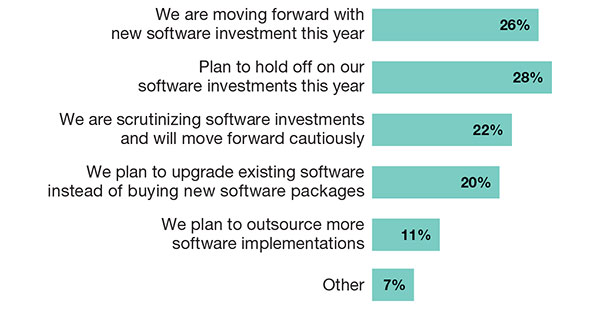
Source: Peerless Media Group (PRG)
More than 100 Modern Materials Handling readers provided input for the online survey. Respondents shared their views of current software usage, returns on investment, and key goals related to their software purchases.
The usage survey covers a range of applications to manage warehouse processes and execution, as well as higher level supply planning and execution functions. The purview of the survey spans everything from WMS and warehouse execution systems (WES) software for DCs, to functions such as supply chain planning, demand planning, distributed order management (DOM) software, as well as transportation management software (TMS).
How would you best describe your company’s adoption of technology for your materials handling procedures?
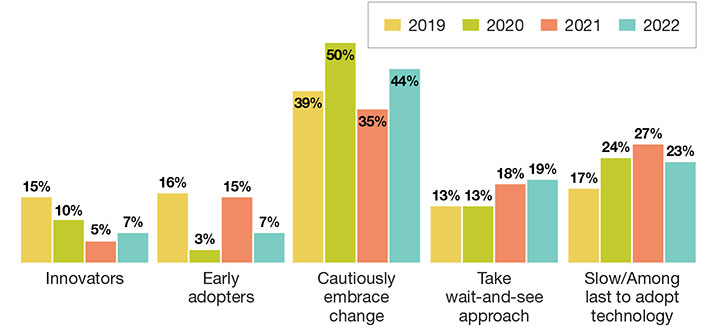
Source: Peerless Media Group (PRG)
Cautiously embracing change
Personally involved in the use, evaluation of and acquisition of software for their company’s materials handling operations, this year’s survey respondents work in the manufacturing (35%), retail/e-tail (16%), wholesale (12%) and consulting (10%) industries.
Sixteen percent of respondents are vice presidents or general managers, while 13% are corporate or divisional managers, and 14% are warehouse managers or supervisors. One-third of the companies (33%) have annual revenues of less than $10 million, while 16% reported revenues of $2.5 billion or more, and 14% reported annual revenues of $100 million to $249.9 million.
Right now, nearly half of the survey respondents (44%) say their company is in the phase of “cautiously embracing change” when it comes to technology, while 19% are taking a wait-and-see approach and 23% say they are moving slow and among the last to adopt technology. Seven percent consider their companies to be “innovators” when it comes to materials handling technology adoption, and 7% identify as early adopters.
Which of the following software applications are currently in use in your warehousing and distribution environment?
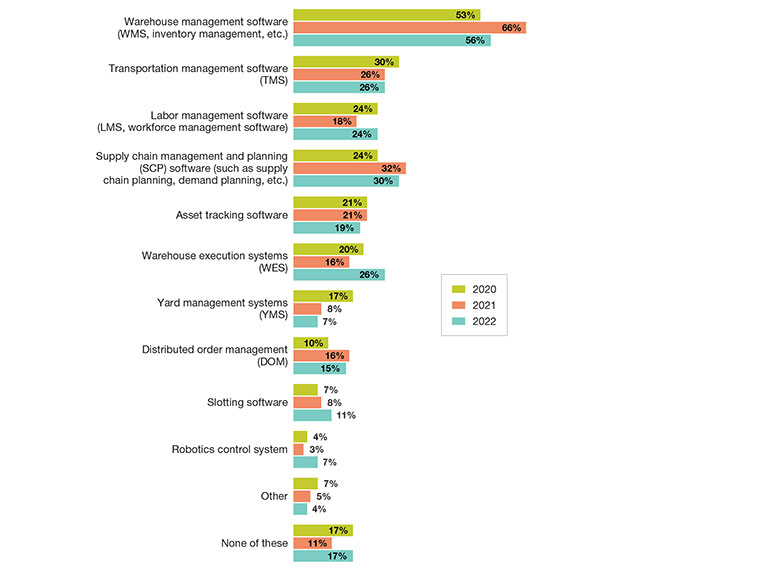
Source: Peerless Media Group (PRG)
The current economic climate has impacted some companies’ approach to adopting materials handling management software, with 28% saying they plan to hold off on software investments in 2022.
However, 26% are moving forward with new software investments and 22% say they are scrutinizing software investments and moving forward cautiously. Twenty percent are planning to upgrade existing software instead of buying new software packages, and 11% plan to outsource more software implementations.
Asked which top issues they’re trying to solve with a new materials handling management software applications, respondents cite productivity, inventory accuracy, accurate visibility of material, cost and time, e-commerce volumes and transparency across supply chains as their biggest pain points.
For most companies, use of materials handling software has not changed over the past two years, with 60% saying usage has stayed the same. Meanwhile, 38% say their materials handling software usage has increased in the past 24 months, and 2% say it has decreased.
Warehouse management solutions reign
Right now, more than half (56%) of companies surveyed are using warehouse management software (WMS, inventory management, etc.), 30% are using supply chain management and planning (SCP) software, and 26% are currently using a transportation management system (TMS).
Additionally, 26% are using warehouse execution systems (WES), 24% are using labor management software (LMS) and 19% are using asset tracking software. Fifteen percent of respondents are using distributed order management (DOM), 11% are using slotting software, 7% are using yard management systems (YMS) and 7% are using a robotic control system.
Asked about the software they plan to evaluate, purchase or upgrade in the next 24 months, 32% of respondents say they’re interested in WMS, 20% want robotic control systems, 19% say LMS and 17% want supply chain management and planning software.
When adopting materials handling software, 39% of respondents say compatibility with existing systems is a major roadblock, while 38% point to integration with existing software applications. Other obstacles to implementation success include the total cost of ownership of such systems (37%); compatibility with host or legacy systems (36%); the lack of resources to implement, manage, and maintain such systems (35%); and substantiating ROI (30%).
Who’s using WMS and for what?
Of the companies that currently have a WMS in place in their warehouse or DC, 10% have had the technology for less than one year, 28% for less than five years and 31% for five to 10 years. Fourteen percent of companies have had their WMS solutions in place for 15+ years.
Many companies have upgraded their WMS since putting it into place. Twenty-eight percent say they upgraded their WMS less than one year ago, 41% say one to less than five years ago and 7% say five to less than 10 years ago. Fifteen percent of respondents have never upgraded their WMS solutions.
For which initiatives is your company using your supply chain management software application?
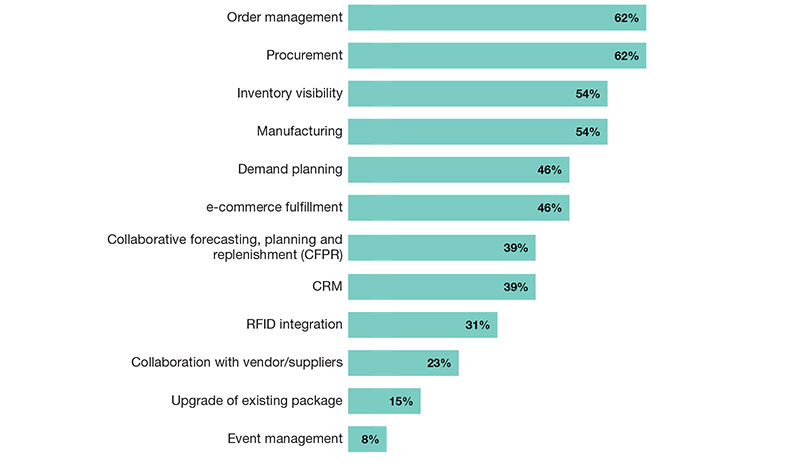
Source: Peerless Media Group (PRG)
Ten percent of respondents realized their WMS ROI within six months or less, but nearly half of readers say they’ve yet to realize the return on their WMS investment or they don’t know if it’s been realized. Fourteen percent say it took more than 18 months to reach their ROI goals, another 14% realized it within 12 to 18 months, and 14% say it took 6 to 12 months.
When asked the main reasons why their company plans on considering or buying a WMS in the next two years, 50% want improved labor management, 48% are looking for real-time control, 43% want to upgrade an existing software package and 39% want better inventory deployment. Thirty-six percent say their drivers are new picking requirements, and 32% say they’re investing in a new WMS due to slotting requirements.
Managing transportation
According to the survey, 36% of respondents have had their TMS in place for one to less than five years, 36% for 5 to 10 years, 14% for 10 to 15 years, and 7% for 15 years or more. Fourteen percent upgraded their TMS less than one year ago, while 43% made that move one to five years ago and 19% have not upgraded at all.
Twenty-one percent of respondents say they realized their TMS ROI in less than six months, while 29% achieved that goal within 6 to 12 months. Twenty-three percent hit the ROI target on their TMS within 12 to 18 months and 19% aren’t sure whether that goal was attained yet.
Supply chain management and planning solution usage
The survey found that 31% of companies have had their supply chain management (SCM) and supply chain planning (SCP) solutions in place for 12 months or less while 23% have been using these solutions for one to five years.
Another 23% say 5 to 10 years and 15% of companies have had their SCM and SCP software in place for 15+ years. Asked about the last time they upgraded their SCM/SCP solutions, 8% say it happened less than one year ago, 8% say 10 to 15 years ago, and 15% have not upgraded these systems.
Why are you or would you use Cloud-based applications? What do you see as the benefits?
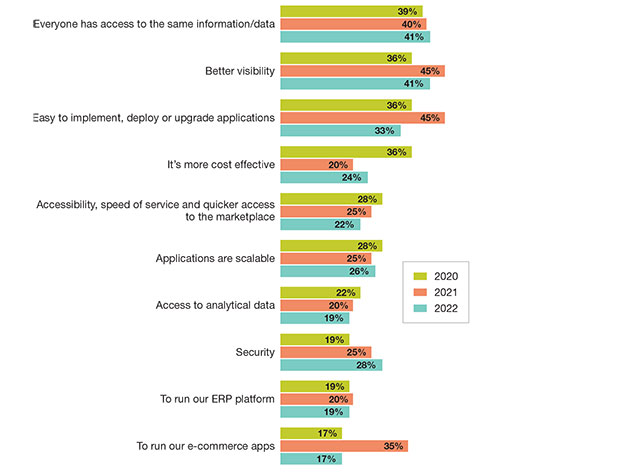
Source: Peerless Media Group (PRG)
Just more than half (54%) of respondents say they haven’t seen—or, aren’t sure if they’ve seen—an ROI from their SCM and SCP solutions yet. Meanwhile, 18% say it took more than 18 months to realize ROI, 10% realized it within 12 to 18 months, and 5% hit the target within six months or less.
Companies are using SCM and SCP for multiple initiatives around the warehouse. Sixty-two percent say they are using the technology for order management, while 62% point to procurement, 54% use it for inventory visibility and 54% to manage manufacturing. Other reasons for investing in SCM and SCP include demand planning (46%), e-commerce fulfillment (46%), collaborative forecasting, planning and replenishment (39%), and customer relationship management (39%).
Adopting new innovations
More than half of companies are running Cloud-based applications, up from 36% in 2021. Eleven percent say they are currently evaluating or plan to evaluate Cloud applications in the next 12 to 24 months, 26% of companies say Cloud computing is not an option for them, and 13% are unsure of their company’s interest in Cloud-based software.
Companies are adopting Cloud-based software for various reasons, with access to the same information and data across all team members (41%), better operational visibility (41%) and ease of implementation (33%) being the top drivers.
Additionally, 28% of survey respondents say security is a key reason for adopting Cloud technology, 26% view the applications as scalable and 24% say the Cloud is more cost effective. The majority (68%) of respondents are using or planning to use Cloud-based WMS, TMS, LMS, slotting and/or order management and planning solutions—up from 60% in 2021.
The survey also covered the future of warehouse and DC software and automation, which may incorporate more Big Data usage, which is currently being used by 23% of respondents (and 41% have no plans to adopt it in the near future).
Twelve percent are currently using artificial intelligence (AI) and another 28% plan to evaluate it at some point. Finally, 20% of respondents are using the Internet of Things (IoT) and 16% are either evaluating or thinking about how IoT can help them digitalize their fulfillment operations.

Article Topics
Software Survey News & Resources
Software usage survey: Spotlight on technology Warehouse Software and Automation Survey 2022: Users cautiously embrace change Software Survey 2021: Goodbye hesitancy, hello resiliency Software Survey: Readers embrace software’s leading role in warehousing and distribution 60 Seconds with… Michael Wohlwend 2018 Software User Survey: We need more technology, please 2017 Software User Survey: Evaluate, purchase, upgrade More Software SurveyLatest in Materials Handling
Registration open for Pack Expo International 2024 Walmart chooses Swisslog AS/RS and software for third milk processing facility NetLogistik partners with Vuzix subsidiary Moviynt to offer mobility solutions for warehouses Materials Handling Robotics: The new world of heterogeneous robotic integration BSLBATT is looking for new distributors and resellers worldwide Lucas Watson appointed CSO for Körber’s Parcel Logistics business in North America Hyster recognizes Dealers of Distinction for 2023 More Materials HandlingAbout the Author
Subscribe to Materials Handling Magazine

Find out what the world's most innovative companies are doing to improve productivity in their plants and distribution centers.
Start your FREE subscription today.
April 2024 Modern Materials Handling

Latest Resources












